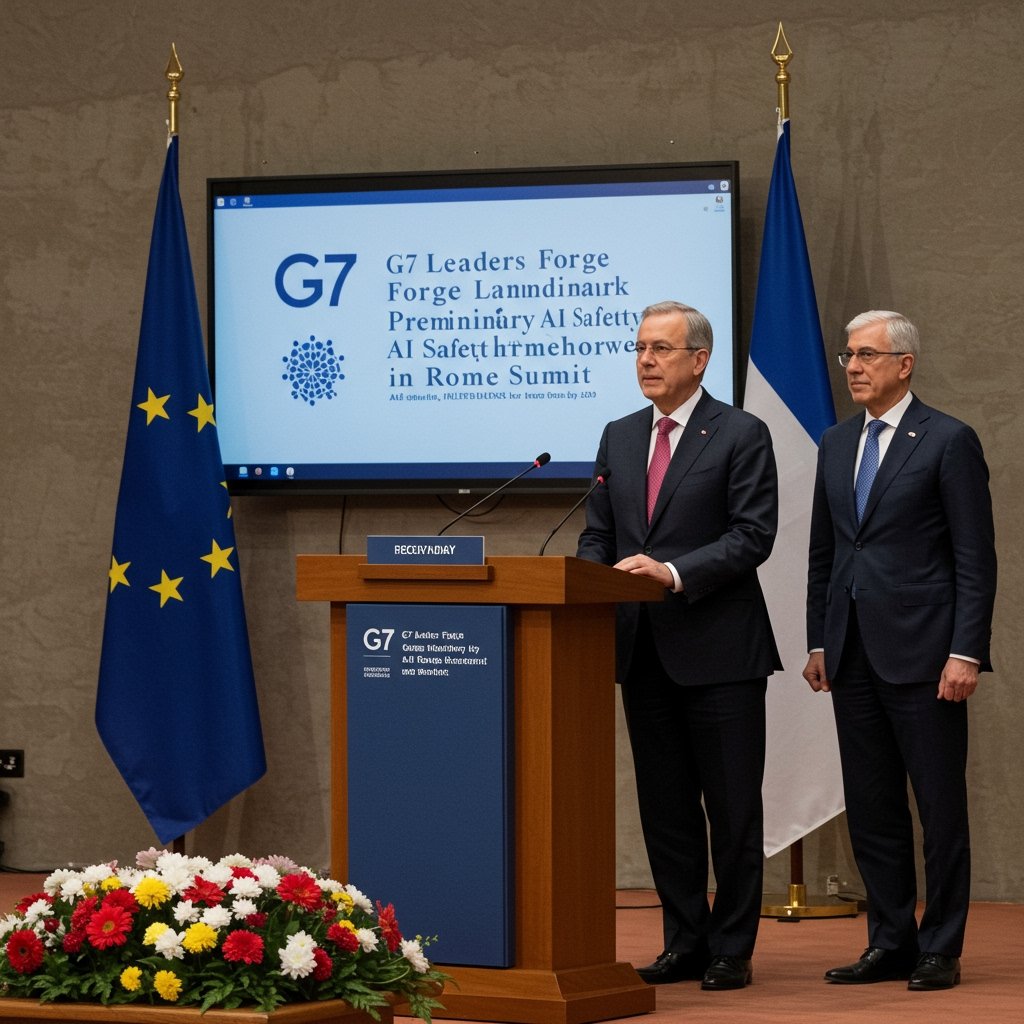G7 Nations Announce Initial Agreement on International AI Safety Standards
Rome, Italy – Leaders from the G7 nations, convening in Rome on June 7, 2025, concluded their summit with a significant announcement: an agreement on a preliminary framework for global AI safety and governance. The accord, detailed in a joint statement issued by the participating heads of state and government, marks a pivotal moment in the international community’s efforts to manage the accelerating evolution of artificial intelligence technology.
The agreement represents a significant first step in establishing coordinated international guardrails amidst the rapid developments in artificial intelligence. For months, policymakers, industry experts, and civil society have grappled with the potential benefits and profound risks associated with increasingly powerful AI models. The G7, comprising some of the world’s most technologically advanced economies, has taken the lead in attempting to translate these discussions into concrete, albeit initial, multilateral action.
The joint statement outlines several key areas of consensus aimed at fostering both innovation and security in the AI landscape. Central to the agreement is a commitment to developing shared risk assessment methodologies. Recognizing that different nations might currently evaluate AI risks using disparate criteria, the G7 leaders agreed on the necessity of harmonizing approaches. This involves working towards common standards for identifying, measuring, and monitoring potential harms arising from AI systems, ranging from bias and misinformation to more complex existential concerns posed by highly advanced models. Establishing a common language and process for risk evaluation is seen as fundamental to enabling effective cross-border collaboration and avoiding regulatory fragmentation.
Another critical component of the preliminary framework involves transparency mandates for frontier AI models. As AI capabilities advance at an unprecedented pace, particularly with large language models and other cutting-edge systems often referred to as “frontier AI,” ensuring their inner workings and potential behaviors are sufficiently understood by developers, regulators, and the public has become a priority. The G7 agreement signals an intent to require developers of these powerful models to provide greater insight into their training data, capabilities, limitations, and testing results. The specifics of these mandates – including what constitutes a “frontier” model and the exact scope of required transparency – will likely be subject to further deliberation, but the principle has been established.
To operationalize and build upon this preliminary framework, the G7 leaders announced the planned formation of a multilateral working group. This group is tasked with translating the principles agreed upon in Rome into more detailed and actionable recommendations and potentially future international accords. The urgency of the task is underscored by the timeline: the joint statement specifies that this working group is intended to be established by September 2025. This tight deadline reflects the G7’s recognition that progress must be swift to keep pace with technological advancements.
The formation of the working group highlights the collaborative spirit the G7 nations aim to foster. Its mandate will likely include exploring mechanisms for information sharing on AI incidents, developing best practices for AI deployment across various sectors, and coordinating research efforts on AI safety and security. It will also need to consider how to involve other nations and international bodies to ensure that the framework eventually evolves into a truly global standard, rather than remaining confined to the G7.
While the Rome agreement is described as a preliminary framework, its significance lies in achieving initial consensus among major global powers on the necessity and direction of international AI governance. Previous discussions on AI regulation have often been fragmented, occurring primarily at national or regional levels. The G7’s joint statement represents a concerted effort to establish a shared foundation upon which more comprehensive and globally applicable rules can be built.
The focus on balancing innovation and security is a delicate one. The G7 nations are keen to harness the transformative potential of AI for economic growth, scientific discovery, and societal benefit. However, they also acknowledge the ethical, social, and safety challenges that rapid AI deployment presents. The framework aims to create an environment where innovation can thrive responsibly, with sufficient safeguards in place to mitigate risks and build public trust.
The challenges ahead remain substantial. Defining common standards across diverse legal and technological landscapes will require intricate negotiations. Ensuring compliance with transparency mandates and risk assessments will necessitate robust monitoring mechanisms. Furthermore, the pace of AI development means that regulatory frameworks must remain adaptable and forward-looking. However, the agreement reached in Rome on June 7, 2025, provides a clear signal of intent and a foundational structure for these complex tasks.
In conclusion, the G7 summit in Rome has successfully delivered an initial, yet critical, international consensus on AI safety and governance. The preliminary framework, encompassing shared risk assessment, transparency for frontier models, and the timely establishment of a multilateral working group, sets the stage for ongoing international cooperation. It underscores the G7’s commitment to navigating the future of artificial intelligence in a manner that promotes both its immense potential and ensures global safety and stability.





